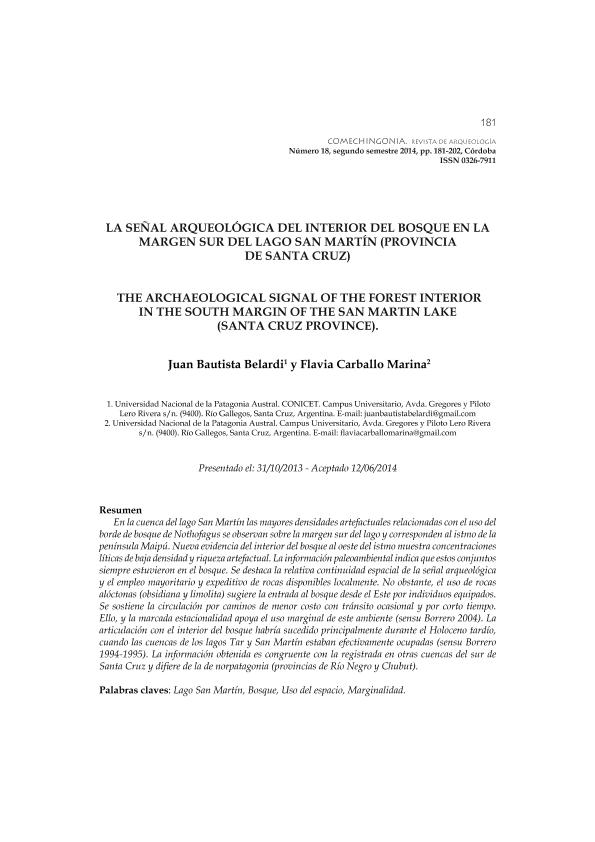Mostrar el registro sencillo del ítem
dc.contributor.author
Belardi, Juan Bautista

dc.contributor.author
Carballo Marina, Flavia Elena

dc.date.available
2020-07-14T12:38:53Z
dc.date.issued
2014-12
dc.identifier.citation
Belardi, Juan Bautista; Carballo Marina, Flavia Elena; La señal arqueológica del interior del bosque en la margen sur del lago San Martín (Provincia de Santa Cruz); Universidad Nacional de Tres de Febrero. Instituto de Estudios Históricos. Centro de Estudios Históricos "Prof. Carlos A. Segreti"; Comechingonia; 18; 2; 12-2014; 181-202
dc.identifier.issn
0326-7911
dc.identifier.uri
http://hdl.handle.net/11336/109200
dc.description.abstract
En la cuenca del lago San Martín las mayores densidades artefactuales relacionadas con el uso del borde de bosque de Nothofagus se observan sobre la margen sur del lago y corresponden al istmo de la península Maipú. Nueva evidencia del interior del bosque al oeste del istmo muestra concentraciones líticas de baja densidad y riqueza artefactual. La información paleoambiental indica que estos conjuntos siempre estuvieron en el bosque. Se destaca la relativa continuidad espacial de la señal arqueológica y el empleo mayoritario y expeditivo de rocas disponibles localmente. No obstante, el uso de rocas alóctonas (obsidiana y limolita) sugiere la entrada al bosque desde el Este por individuos equipados. Se sostiene la circulación por caminos de menor costo con tránsito ocasional y por corto tiempo. Ello, y la marcada estacionalidad apoya el uso marginal de este ambiente (sensu Borrero 2004). La articulación con el interior del bosque habría sucedido principalmente durante el Holoceno tardío, cuando las cuencas de los lagos Tar y San Martín estaban efectivamente ocupadas (sensu Borrero 1994-1995). La información obtenida es congruente con la registrada en otras cuencas del sur de Santa Cruz y difiere de la de norpatagonia (provincias de Río Negro y Chubut).
dc.description.abstract
The highest artifactual densities related to hunter-gatherer forest edge use at the San Martin Lake basin were observed in its South shore, on the Maipú Península isthmus. New evidence from the forest interior shows lithic assemblages characterized by low density and richness. Palaeoenvironmental data indicate that these assemblages had always been in the forest. The continuity of the archaeological signal and the main and expeditive use of locally available rocks are worth noting. Nevertheless, artifacts made on aloctonous rocks (obsidian and siltstone) suggest that the coming into the forest was done from the East by equipped individuals. The occasional and short time circulation using low cost paths is sustained. This last evidence and the great seasonality point to the marginal use of the forest (sensu Borrero 2004). The forest-steppe articulation could have occurred principally during the Late Holocene, when the Tar and San Martin Lake basins were already part of the hunter-gatherer landscape (sensu Borrero 1994-1995). The available archaeological information fits the one registered in other basins from southern Santa Cruz Province and differs from North Patagonia (Río Negro and Chubut Provinces) data.
dc.format
application/pdf
dc.language.iso
spa
dc.publisher
Universidad Nacional de Tres de Febrero. Instituto de Estudios Históricos. Centro de Estudios Históricos "Prof. Carlos A. Segreti"
dc.rights
info:eu-repo/semantics/openAccess
dc.rights.uri
https://creativecommons.org/licenses/by-sa/2.5/ar/
dc.subject
LAGO SAN MARTIN
dc.subject
BOSQUE
dc.subject
USO DEL ESPACIO
dc.subject
MARGINALIDAD
dc.subject.classification
Arqueología

dc.subject.classification
Historia y Arqueología

dc.subject.classification
HUMANIDADES

dc.title
La señal arqueológica del interior del bosque en la margen sur del lago San Martín (Provincia de Santa Cruz)
dc.title
The archaeological signal of the forest interior in the south margin of the San Martin lake (Santa Cruz province)
dc.type
info:eu-repo/semantics/article
dc.type
info:ar-repo/semantics/artículo
dc.type
info:eu-repo/semantics/publishedVersion
dc.date.updated
2020-07-13T21:16:38Z
dc.identifier.eissn
2250-7728
dc.journal.volume
18
dc.journal.number
2
dc.journal.pagination
181-202
dc.journal.pais
Argentina

dc.journal.ciudad
Córdoba
dc.description.fil
Fil: Belardi, Juan Bautista. Universidad Nacional de la Patagonia Austral; Argentina. Consejo Nacional de Investigaciones Científicas y Técnicas; Argentina
dc.description.fil
Fil: Carballo Marina, Flavia Elena. Universidad Nacional de la Patagonia Austral; Argentina
dc.journal.title
Comechingonia
dc.relation.alternativeid
info:eu-repo/semantics/altIdentifier/url/https://revistas.unc.edu.ar/index.php/comechingonia/article/view/18160
dc.relation.alternativeid
info:eu-repo/semantics/altIdentifier/doi/https://doi.org/10.37603/2250.7728.v18.n2.18160
Archivos asociados
